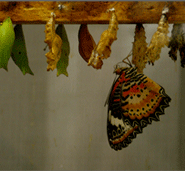The mysterious inner life, like a mischievous child peering into the living room after his bedtime, shows itself at the oddest, most inconvenient hours. You are at your own party, surrounded by food and alcohol and laughter and then poof! There it is, invisible and omnipresent. Your inner life, sweeping in for the kill, overwhelms all your senses and sound reasoning.
Suddenly, you are thinking about your imperfections, the emotions undone, the love unrequited, the life unlived. Suddenly, you are lost. Suddenly, you are useless. And suddenly, you pick a person, at random, to vent to, “it’s this big feeling, you know, like the galaxies and so far away, found in my cup of wine, into my soap dispenser and my salt, and I, pulled taut, don’t know what to do with it”. They stare at you blankly. “So anyway, I think they’re on a break. Can you imagine? After nine years?” This is the inner life. The great disjunction between the startling and momentary awareness of being alive and being alone and the delusion of forgetting this and laughing at trivialities that don’t concern you.
But the inner life does not mean to make you cynical. In fact, it forces its way in only when it knows the door already lies ajar. It yearns for your acceptance, it seeks your company. When you accept this duality within you, the dualities without are not disconcertingly ironic; rather, they divide you back, make you multiple. They make you confront the big, difficult questions. When we allow this little child in, to laugh and learn with us, answer his curious questions and listen to his concoctions, we are not lonely anymore. We allow new possibilities and accept the accidental and the irregular. So what if he sleeps through gym tomorrow.
Each of the stories in our non-fiction issues begin with the physical-tangible, and gradually assume lives of their own. They resurrect the past and ponder the unknown through the known.
Non Fiction then becomes, as Sheba Karim puts it in the story 'Resurrection', "historical fabrication". Even as truth and reality is not absolute and we seek the objective, or the rational, "life" enters, or the ghosts of our ancestors haunt us into recreating our present through a history that we did not see.
Angela Evancie describes a self-aware moment of confronting our collective present through a seemingly innocuous visit to a large, abandoned space in Cleveland, USA. But the essay becomes larger than the space in that it transcends its location, and begins to speak of architecture's potential to restore an imagination of the past as well as allow its sediment to rub against something of the now and the later.
Sheba Karim, in response to Manjari Kaul's prompts from author's of the past, reveals the process of writing the biography of a female monarch from 13th Century India. She navigates the lines between researching facts and her own consciousness that breathes feminine life into a forgotten character.
Anirudh Karnick's story is, I have to use the word despite all groans, meta. His essay is on the writing of a poignant Indian writer of the arts, Aveek Sen, Senior Editor of The Telegraph, for whom non fiction straddles the lines between the felt subject and the feeling observer.
And finally, Waylon D'Mello imagines a story behind a series of photographs that settled an argument. He suggests, through the work of Kapil Das, that perhaps even photography, as objective as it claims to be, might offer a very particular angle on a very particular truth.
And so this inner life manifests at the heart of each of these stories, fictionalized or not. We create in contradiction, not conjunction. We fill characters with two gazes, convex and concave, both reflecting in and out and back at each other. This is, perhaps, why we read: in stories, our characters say things, see things, and in between, a first, second or third person gazes into a criss-cross of light in which we see our muddled likenesses. So much so, that, as a wise man once said, the book begins to read us. It reads our inconsistencies, our failures, our fears.
The entryway into this id is to travel to the worlds of these photographs and the tales they tell, to learn the facts then lose perspective, regain perspective and through the characters you encounter, meet a half-asleep, half-awake, part of your self too.
With two lives,
Himali.
Editor's Note.
Every sunbeam, every strain of music, every sapling and starfish is ultimately the regeneration of a previous something, a collection of somethings, taking on new shape. At the most indivisible level we can comprehend, all life is nothing more than atoms and molecules dancing their way through various forms. And if everything comes from something, it stands to reason that everything must go to something as well.
Read More
Illusion: Seeing Beyond Seeing
Meaning: In Search of Significance.
Melody: A Different Tune
Rhythm: Ordering Time


